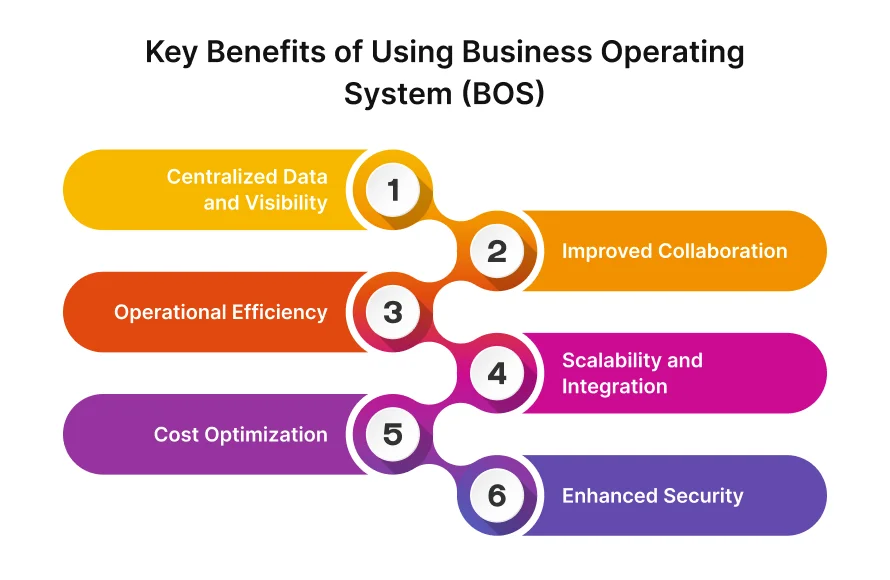Every IT company strives for efficiency, yet many unknowingly build operations on a foundation of fragmented tools. What begins as an attempt to stay organized, using separate work management systems for communication, streamlining HR operations, project management, sales management, reporting, capacity management, etc.
However, it often results in the opposite: scattered data, misaligned teams, and growing operational friction. The more tools added to the stack, the harder it becomes to manage them. Processes slow down, accountability weakens, and valuable time is lost managing systems instead of delivering results. What was meant to empower teams ends up limiting them.
A unified Business Operating System (BOS) offers a different path: one that connects every aspect of your IT organization in a single, streamlined environment. By centralizing data, communication, and workflow automation, it transforms how companies operate, collaborate, and scale.
In this blog ahead, we’ll explore why leading IT companies are replacing multiple disconnected tools with one powerful business operating system and how that shift is redefining operational excellence in the industry.
How Too Many Tools Are Slowing Down Your IT Operations
There are many reasons why IT operations slow down when too many tools are involved, including tool overload, fragmented data, and constant switching between platforms.
Additional issues such as productivity loss, rising software costs, and increased security and compliance risks further compound the problem. Together, they build an operational environment that becomes harder to manage over time. Here is how they impact the organization:
1. Tool Overload
When every department uses a different set of tools, your tech stack becomes bloated and disjointed. Project managers, developers, HR, and sales teams all work in separate systems, creating silos that slow down collaboration and increase confusion. The more tools added, the more complex integrations become, leading to inefficiency and constant operational friction.
2. Fragmented Data
With information scattered across multiple platforms, it’s nearly impossible to maintain a single source of truth. Data duplication, outdated reports, and inconsistent metrics make it difficult to track progress or make informed decisions. For leadership, this lack of unified visibility often results in reactive management rather than strategic control.
3. Productivity Loss
Constantly switching between tools disrupts workflow and focus. Employees spend valuable time logging into different systems, reconciling updates, and fixing data inconsistencies, instead of focusing on core deliverables. Over time, this inefficiency compounds, leading to missed deadlines, communication breakdowns, and lower overall output.
4. Rising Costs
Each additional tool adds its own subscription fees, integration requirements, and maintenance costs. As the number of platforms grows, so do hidden expenses, from employee training and duplicate features to technical support and API management. What starts as a low-cost solution can quickly become a financial drain.
5. Security and Compliance Risks
The more tools you use, the greater your exposure to security vulnerabilities. Each system comes with its own access controls, permissions, and data storage policies, making it harder to maintain consistent compliance. For IT companies that handle sensitive client data, these gaps can lead to serious reputational and regulatory risks.

What is a Business Operating System (BOS)?
A Business Operating System (BOS) is a unified platform designed to manage all the critical functions of an organization through a single, integrated system. Instead of relying on multiple standalone tools that create data silos and communication gaps, a BOS connects every operational area, offering complete visibility, consistency, and control across the business.
A modern BOS typically encompasses essential modules that form the backbone of efficient operations. Such as:
1. People Management Module: Simplifies workforce oversight by managing attendance, performance, roles, and responsibilities in one place. This people management module ensures smoother coordination, stronger accountability, and improved employee engagement.
2. Project Management Module: Streamlines how teams plan, execute, and deliver work. From task assignments to progress tracking and collaboration, this project management module ensures every project stays on schedule, within scope, and aligned with organizational goals.
3. Sales & CRM Module: Consolidates customer relationships, sales pipelines, and communication channels. A unified CRM module helps with sales management, nurtures leads, tracks opportunities, and converts prospects efficiently while keeping customer data organized and accessible.
4. Recruitment Module: Automates and manages the hiring process, from job posting and candidate tracking to onboarding, helping companies attract top talent and build stronger teams with less administrative effort.
5. Reporting Module: Provides real-time insights into performance, productivity, and profitability. With centralized analytics and dashboards, decision-makers can track KPIs, identify trends, and make data-driven choices without toggling between multiple systems.
Together, these modules create a cohesive operational ecosystem: one platform that manages people, projects, performance, and profitability. For IT companies, a BOS is about empowering every department to operate in sync, with transparency and speed.
Key Benefits of Using Business Operating System (BOS)

There are many ways a Business Operating System elevates overall performance, including unified information management, clearer organizational visibility, and stronger team coordination. Additional gains such as streamlined operations, flexible scalability, reduced operational costs, and reinforced security standards further strengthen the company’s foundation.
Together, these advantages enable businesses to operate with greater consistency, make faster decisions, and move away from the complications of scattered tools. Here is what each benefit brings to the organization:
1. Centralized Data and Visibility
A BOS consolidates information into a single source, providing a consistent, data-driven, and transparent environment. Instead of piecing together information from disconnected tools, teams can access accurate insights instantly. This unified visibility helps identify bottlenecks, monitor performance trends, and maintain alignment across departments without dependency on manual reporting.
2. Improved Collaboration
A BOS centralizes communication, tasks, and workflows in one organized system. Departments share updates seamlessly, coordinate responsibilities with greater clarity, and maintain complete context throughout projects. This reduces delays, minimizes miscommunication, and supports stronger cross-team collaboration.
3. Operational Efficiency
A BOS streamlines how work flows across departments through automated processes and standardized procedures. Routine tasks require less manual effort, turnaround times improve, and errors decrease significantly. Teams maintain consistent momentum, and managers gain clearer oversight with fewer administrative interruptions.
4. Scalability and Integration
A BOS adapts as the organization grows, supporting new team structures, services, and operational demands without adding complexity. Integration capabilities ensure compatibility with existing tools when necessary, allowing companies to expand while keeping systems unified and stable.
5. Cost Optimization
A BOS reduces reliance on multiple software subscriptions and eliminates hidden inefficiencies such as duplicated tasks, repeated data entry, and fragmented workflows. Consolidated operations lead to better resource utilization, fewer redundant expenses, and a more cost-effective operational model.
6. Enhanced Security
A BOS centralizes sensitive data within a secure, controlled framework that follows consistent access and compliance standards. Role-based permissions, monitoring features, and unified security policies reduce vulnerabilities and strengthen protection compared to managing several disconnected tools.

How to Transition from Multiple Tools to One Business OS
There are several steps involved in shifting from a scattered tool environment to a unified BOS, including evaluating the current tool landscape, understanding business needs, and identifying the most suitable platform.
Additional phases, such as planning a phased migration, training teams, and standardizing processes, ensure the transition is smooth, controlled, and sustainable. Together, these steps create a clear roadmap that helps organizations adopt a Business OS with confidence and minimal disruption. Here is what the transition journey looks like:
1. Assess Current Tool Usage
Conduct a thorough evaluation of the existing tool stack to gain clarity on what’s functioning well, what’s redundant, and where operational gaps exist. Understand how each department uses its tools, along with associated costs, data flows, and integration challenges, to establish a solid foundation for a smooth and effective transition.
2. Define Business and IT Requirements
Evaluate potential Business OS platforms against key criteria such as capabilities, scalability, customization options, security measures, and vendor support. Ensure the system addresses existing gaps, replaces unnecessary tools, and improves overall efficiency without introducing additional complexity.
3. Select the Right Business OS
Evaluate potential Business OS platforms against key criteria such as capabilities, scalability, customization options, security measures, and vendor support. Ensure the system addresses existing gaps, replaces unnecessary tools, and improves overall efficiency without introducing additional complexity.
4. Plan Gradual Migration
Adopt a phased migration approach to limit disruption and reduce implementation risks. Identify which modules or teams should transition first to allow smoother onboarding and quicker value realization. Structure the timeline to include data migration, workflow adjustments, and configuration activities in an organized sequence.
5. Train Teams and Standardize Processes
Provide structured training to ensure teams understand how to use the new system confidently and correctly. Establish standardized processes to maintain consistency across departments and help employees adapt to the new environment. Support ongoing adoption with documentation, guidance, and continuous learning resources.
Conclusion
When tools become the focus, the business itself stops moving forward. Transitioning to a Business Operating System helps leaders redirect their attention to strategy, value delivery, and team performance instead of troubleshooting scattered software. This shift enables IT companies to operate with greater consistency, transparency, and accountability, bringing long-term stability and impact.

Why CollabCRM Is the Best Business Operating System for Your Company
CollabCRM stands out as an ideal Business Operating System because it is built to replace fragmented, multi-tool environments with one connected, easy-to-manage platform. Instead of forcing teams to switch abruptly, CollabCRM supports a smooth transition.
It consolidates modules such as people management, sales and CRM, project delivery, recruitment, and reporting into a single ecosystem. The platform brings structure to daily workflows, creates harmony between departments, and eliminates the friction that comes from juggling disconnected systems.
Its real-time visibility, automated processes, and tightly integrated modules ensure that organizations don’t just migrate to a new system; they elevate how they work. From centralizing data to aligning teams under one reliable source of truth, CollabCRM makes it significantly easier for businesses to scale without chaos and build a strong operational foundation for long-term growth.
FAQs
Companies struggle because multiple tools create data silos, duplicate work, and inconsistent processes. Employees waste time switching between systems, and leaders lose visibility into performance. Over time, this fragmentation slows operations, increases costs, and complicates collaboration.
A Business Operating System is an all-in-one platform that unifies core functions across the organization. Traditional software solves isolated problems, but a Business OS connects people, data, workflows, and reporting in one place. This creates consistency, reduces complexity, and improves operational clarity.
Common signs include teams working in silos, data scattered across multiple tools, rising software costs, and frequent communication issues. If employees spend more time managing tools than completing work, or leadership lacks real-time visibility, it’s time to switch to a Business OS.
CollabCRM centralizes people management, CRM, projects, recruitment, and reporting in one platform. By replacing multiple standalone apps, it eliminates data duplication, streamlines workflows, and gives teams a single platform to operate from, reducing cost and complexity.
Yes. CollabCRM is designed to scale with small teams, growing companies, and large organizations alike. Its modular structure allows businesses to start with essential features and expand as their needs evolve, ensuring long-term flexibility.
CollabCRM follows industry-standard security practices, including data encryption, role-based access, secure cloud infrastructure, and regular compliance updates. With centralized controls, it’s easier to protect sensitive information and maintain consistent security policies across the organization.
The transition is designed to be smooth, with minimal disruption. Teams typically experience an initial learning phase, followed by significantly improved efficiency. Once implemented, a Business OS simplifies daily workflows, reduces manual tasks, and enhances collaboration across departments.





